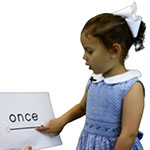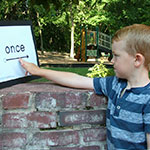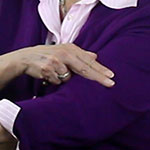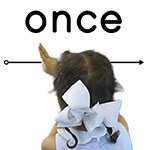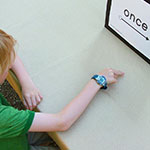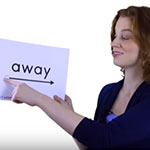Spelling
Before You Start
Look for patterns in the word list that you can point out to your child.
A. Spell Reading
The child says the word and spells out the letters, then reads the word again.
B. Arm Tapping
The child says the word and then spells out the letters while tapping them on her arm.
C. Air Writing
A child says the word, then writes the letters in the air in front of the flash card.
D. Table Writing
A child writes the letters on a table, first looking at and then not looking at the flash card.
Corrections Procedure
Correct a child’s mistake by clearly stating and reinforcing the right word several times.
1. Look for Patterns
Look for patterns in the word list: multiple words in the same word family (e.g., bat, cat, mat), with the same letters (e.g., bean, clean, mean), or with the same special sound (e.g., ship, brush, shell).
If you find any pattern — even just two or three words out of a ten-word list — work on those similar words as a group with your child. Pointing out and emphasizing the pattern in the words will help your child to remember them.
2. Sing & Spell
Music and rhythm are incredible memory tools. If your child can sing or chant the spelling of a word, it will be so much easier for her to remember it during a quiz or test.
Songs are great, and non-singers or wannabe cheerleaders can use rhythmic chants instead. Here are some suggestions to use for learning words of different lengths.
2.1 Two-Letter Words
The tune for “If You’re Happy and You Know It” is perfect for teaching two-letter words.
If you’re happy and you know it, spell at.
a-t!
If you’re happy and you know it, spell at.
a-t!
If you’re happy and you know it, then your face will surely show it.
If you’re happy and you know it, spell at.
a-t!
2.1 Three-Letter Words
“Mary Had a Little Lamb” is a simple tune that all children will know.
Spell the word big: b-i-g,
b-i-g, b-i-g
Spell the word big: b-i-g,
All day long!
The tune for “Are You Sleeping, Brother John?” — also known as “Frere Jacques” or “Where Is Thumbkin?” — is another tune that’s familiar to most young children.
I can spell dog. I can spell dog.
d-o-g. d-o-g.
This word has three letters, now I’ll spell it better.
d-o-g. d-o-g.
2.1 Four-Letter Words
Use “Oh My Darling Clementine” to help your child learn words with four letters:
b-l-u-e, b-l-u-e,
b-l-u-e spells blue.
b-l-u-e, b-l-u-e,
b-l-u-e spells blue.
2.2 Five-Letter Words
The classic children’s song “Bingo” is perfect for committing five-letter words to memory. Just sing the second part of the song, the part with the spelling:
b-r-u-s-h, b-r-u-s-h, b-r-u-s-h
Is how we spell the word brush!
Another option is the tune for “Old MacDonald Had a Farm“:
How do we spell the word green?
g-r-e-e-n!
The five letters in green are what?
g-r-e-e-n!
2.3 Six-Letter Words
Use “Jingle Bells” to teach six-letter words:
b-u-c-k-e-t,
Bucket is my word!
b-u-c-k-e-t is the
way bucket is spelled!
2.4 Seven-Letter Words
Seven-letter words can be tough, so here are two options for spelling songs:
“Mary Had a Little Lamb” is a simple tune that all children will know.
c-o-u-n-t-r-y,
Spells country, spells country.
c-o-u-n-t-r-y
Is how we spell country.
Teach your child to spell seven-letter words, and at the same time introduce him to a classic Motown song: Aretha Franklin’s “Respect“!
c-o-u-n-t-r-y!
That is how you spell country!
c-o-u-n-t-r-y!
Country! We’re spelling country, yow!
3. Sight Words Teaching Techniques
Introduce new sight words using this sequence of five teaching techniques:
- Spell Reading — The child says the word and spells out the letters, then reads the word again.
- Arm Tapping — The child says the word and then spells out the letters while tapping them on his arm, then reads the word again.
- Air Writing — A child says the word, then writes the letters in the air in front of the flash card.
- Table Writing — A child writes the letters on a table, first looking at and then not looking at the flash card.
These techniques work together to activate different parts of the brain. The exercises combine many repetitions of the word (seeing, hearing, speaking, spelling, and writing) with physical movements that focus the child’s attention and cement each word into the child’s long-term memory.
The lessons get the child up to a baseline level of competence that is then reinforced by the games, which take them up to the level of mastery. All you need is a flash card for each of the sight words you are covering in the lesson.
4. Correcting Mistakes
Of course, every child will make mistakes in the process of learning sight words. They might get confused between similar-looking words or struggle to remember phonetically irregular words.
Use our Corrections Procedure every time your child makes a mistake in a sight words lesson or game. Simple and straightforward, it focuses on reinforcing the correct identification and pronunciation of the word. It can be done quickly without disrupting the flow of the activity.
Do not scold the child for making a mistake or even repeat the incorrect word. Just reinforce the correct word using our script, and then move on.
5. Frequently Asked Questions
Q: Progress is slow. We have been on the same five words for a week!
A: It is not unusual to have to repeat the same set of words several times, especially in the first weeks of sight words instruction. The child is learning how to learn the words and is developing pattern recognition approaches that will speed his progress. Give him time to grow confident with his current set of words, and avoid overwhelming the child with new words when he hasn’t yet become familiar with the old words.
Q: Do I really need to do all five techniques for every word?
A: Start out by using all five techniques with each new word. The techniques use different teaching methods and physical senses to support and reinforce the child’s memorization of the word. After a few weeks of lessons, you will have a sense for how long it takes your child to learn new words and whether all five exercises are necessary. Start by eliminating the last activity, Table Writing, but be sure to review those words at the next lesson to see if the child actually retained them without that last exercise. If the child learns fine without Table Writing, then you can try leaving out the fourth technique, Air Writing. Children who learn quickly may only need to use two or three of the techniques.
Q: How long will it take to get through a whole word list? I want my child to learn ALL the words!!!
A: That depends on a number of factors, including frequency of your lessons as well as your child’s ability to focus. But do not get obsessed with the idea of racing through the word lists to the finish line. It is much, much better for your child to solidly know just 50 words than to “kind of” know 300 words. We are building a foundation here, and we want that foundation to be made of rock, not sand!

